Nerve Impulse | Zoology Optional Notes for UPSC PDF Download
| Table of contents |

|
| Introduction |

|
| Resting Membrane Potential |

|
| Action Potential |

|
| Myelin and the Propagation of the Action Potential |

|
| Synaptic Transmission |

|
| Synaptic Plasticity |

|
Introduction
The nervous system performs a range of functions, from basic motor reflexes to complex activities like memory formation and decision-making. Communication between neurons is essential for these functions. Unlike humans who communicate through words and body language, neurons rely on electrical and chemical signals. Similar to an individual in a committee, a neuron typically receives and integrates messages from several other neurons before deciding to transmit the message to additional neurons.
Nerve Impulse Transmission within a Neuron
For the nervous system to operate, neurons need to transmit and receive signals. This capability arises from the presence of a charged cellular membrane in each neuron, creating a voltage difference between the inside and outside. The membrane charge can be altered in reaction to neurotransmitter molecules released by other neurons and external stimuli. To comprehend the communication process of neurons, it is essential to grasp the foundation of the baseline or 'resting' membrane charge.
Neuronal Charged Membranes
The lipid bilayer membrane enveloping a neuron is impermeable to charged molecules or ions. Ions must traverse specialized proteins known as ion channels, spanning the membrane, to enter or exit the neuron. These ion channels exist in different states: open, closed, and inactive, as depicted in Figure 42.2.1. Certain ion channels necessitate activation to open, facilitating the passage of ions in and out of the cell. Responsive to environmental cues, these ion channels can alter their configuration accordingly. Ion channels that adjust their structure in response to voltage variations are termed voltage-gated ion channels. They play a role in regulating the concentrations of different ions inside and outside the cell, determining the membrane potential, which is the disparity in total charge between the cell's interior and exterior.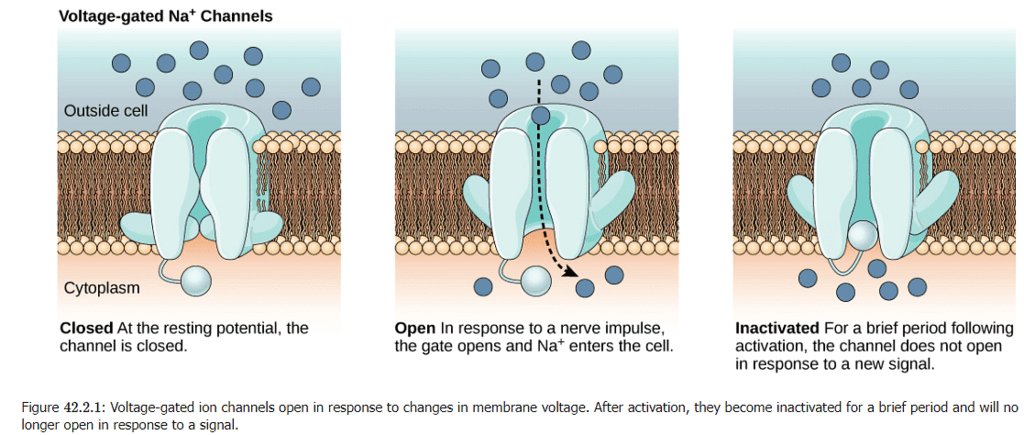
Resting Membrane Potential
A neuron in its resting state exhibits a negative charge, with the interior of the cell approximately 70 millivolts more negative than the exterior (−70 mV, though this value may vary among neuron types and species). This voltage is referred to as the resting membrane potential, a consequence of ion concentration disparities inside and outside the cell. If the membrane were equally permeable to all ions, an equilibrium would be reached, as each ion type would freely traverse the membrane. However, since ions face restrictions in crossing the membrane, distinct concentrations of various ions exist both inside and outside the cell, as indicated in the table below. The primary contributor to the resting membrane potential is the difference in the quantity of positively charged potassium ions (K+) inside and outside the cell, leading to a negative potential (Figure 42.2.2). During the resting state, K+ ions accumulate within the cell due to a net movement in the direction of the concentration gradient. The negative resting membrane potential is established and sustained by elevating the concentration of cations outside the cell (extracellular fluid) compared to inside the cell (cytoplasm). This negative charge within the cell arises from the membrane's greater permeability to potassium ion movement than to sodium ion movement. In neurons, potassium ions are maintained at high levels inside the cell, while sodium ions are maintained at high levels outside the cell. The cell is equipped with potassium and sodium leakage channels that allow these cations to diffuse along their concentration gradients. Notably, neurons possess a larger number of potassium leakage channels than sodium leakage channels. Consequently, potassium diffuses out of the cell at a faster rate than sodium leaks in. This imbalance, where more cations exit the cell than enter, results in a negative charge within the cell relative to the extracellular fluid. The sodium-potassium pump plays a role in maintaining the established resting potential. It functions by transporting two K+ ions into the cell while expelling three Na+ ions per ATP consumed. As more cations are expelled than taken in, the cell's interior remains negatively charged compared to the extracellular fluid. It's important to mention that calcium ions (Cl–) tend to accumulate outside the cell due to their repulsion by negatively charged proteins in the cytoplasm.

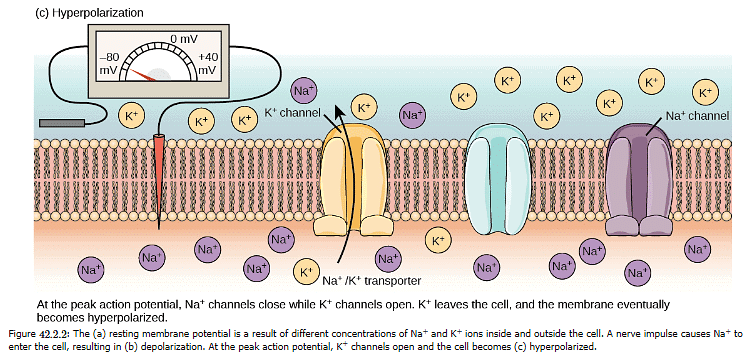
Action Potential
A neuron has the ability to receive input from other neurons, and if this input reaches a sufficient strength, the neuron can transmit the signal to downstream neurons. The transmission of a signal between neurons primarily involves the use of neurotransmitters, while the transmission of a signal within a neuron, from dendrite to axon terminal, is facilitated by a transient reversal of the resting membrane potential known as an action potential. When neurotransmitter molecules bind to receptors on a neuron's dendrites, ion channels open. At excitatory synapses, this opening allows positive ions to enter the neuron, leading to membrane depolarization—a reduction in the voltage difference between the inside and outside of the neuron. An external stimulus, originating from a sensory cell or another neuron, depolarizes the target neuron until it reaches its threshold potential (-55 mV). Subsequently, Na+ channels in the axon hillock open, enabling positive ions to enter the cell (Figure 42.2.3 and Figure 42.2.4). Once these sodium channels open, the neuron undergoes complete depolarization, reaching a membrane potential of approximately +40 mV. Action potentials are characterized as "all-or-nothing" events, meaning that once the threshold potential is attained, the neuron invariably experiences complete depolarization. Following depolarization, the cell enters a refractory period during which it cannot generate another action potential since its sodium channels remain closed. Concurrently, voltage-gated K+ channels open, allowing K+ to exit the cell. As K+ ions leave the cell, the membrane potential once again becomes negative. The efflux of K+ actually hyperpolarizes the cell, causing the membrane potential to become more negative than the cell's typical resting potential. At this stage, the sodium channels revert to their resting state, indicating their readiness to open again if the membrane potential exceeds the threshold. Eventually, the excess K+ ions diffuse out of the cell through potassium leakage channels, restoring the cell from its hyperpolarized state to its resting membrane potential.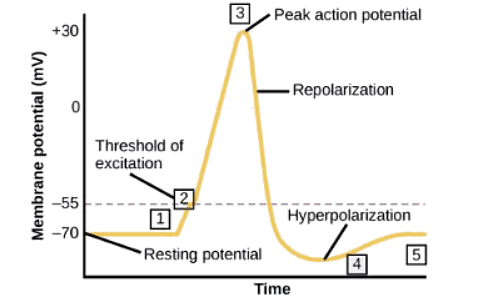
Figure 42.2.3: The formation of an action potential can be divided into five steps: (1) A stimulus from a sensory cell or another neuron causes the target cell to depolarize toward the threshold potential. (2) If the threshold of excitation is reached, all Na+ channels open and the membrane depolarizes. (3) At the peak action potential, K+ channels open and K+ begins to leave the cell. At the same time, Na+ channels close. (4) The membrane becomes hyperpolarized as K+ ions continue to leave the cell. The hyperpolarized membrane is in a refractory period and cannot fire. (5) The K+ channels close and the Na+/K+ transporter restores the resting potential.
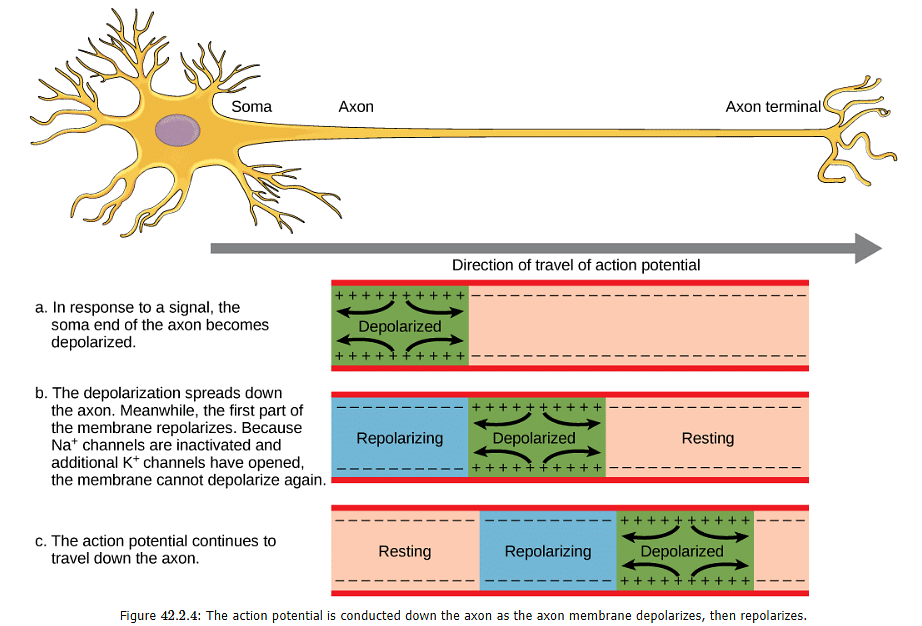
Myelin and the Propagation of the Action Potential
For an action potential to convey information to another neuron, it must travel along the axon and reach the axon terminals, initiating the release of neurotransmitters. The speed of action potential conduction along an axon is influenced by both the axon's diameter and its resistance to current leakage. Myelin serves as an insulating layer that prevents the leakage of current from the axon, thereby increasing the speed of action potential conduction. In conditions characterized by demyelination, such as multiple sclerosis, the conduction of action potentials slows down due to the leakage of current from regions of the axon that were previously insulated. The nodes of Ranvier, depicted in Figure 42.2.5, represent gaps in the myelin sheath along the axon. These unmyelinated segments, approximately one micrometer in length, contain voltage-gated Na+ and K+ channels. Ion flow through these channels, particularly the Na+ channels, regenerates the action potential along the axon repeatedly. This phenomenon, known as saltatory conduction, involves the "jumping" of the action potential from one node to the next. Without the presence of nodes of Ranvier along an axon, the action potential would propagate very slowly, as Na+ and K+ channels would need to continuously regenerate action potentials at every point along the axon rather than at specific points. Nodes of Ranvier also contribute to energy conservation for the neuron, as the channels only need to be present at these nodes and not along the entire length of the axon.
Synaptic Transmission
The synapse, or the junction where information is transferred from one neuron to another, is a crucial site in neural communication. Typically, synapses are established between axon terminals and dendritic spines, although variations exist, such as axon-to-axon, dendrite-to-dendrite, and axon-to-cell body synapses. The neuron transmitting the signal is referred to as the presynaptic neuron, while the neuron receiving the signal is termed the postsynaptic neuron. It's important to note that these designations are context-dependent, as most neurons can function as both presynaptic and postsynaptic. Synapses can be categorized into two types: chemical and electrical.
Chemical Synapse
Upon reaching the axon terminal, an action potential induces membrane depolarization, leading to the opening of voltage-gated Na+ channels. This allows Na+ ions to enter the cell, intensifying the depolarization of the presynaptic membrane. The depolarization triggers the opening of voltage-gated Ca2+ channels. The influx of calcium ions initiates a signaling cascade, prompting the fusion of small membrane-bound vesicles known as synaptic vesicles with the presynaptic membrane. The synaptic vesicles, containing neurotransmitter molecules, are illustrated in Figure 42.2.6, captured using a scanning electron microscope.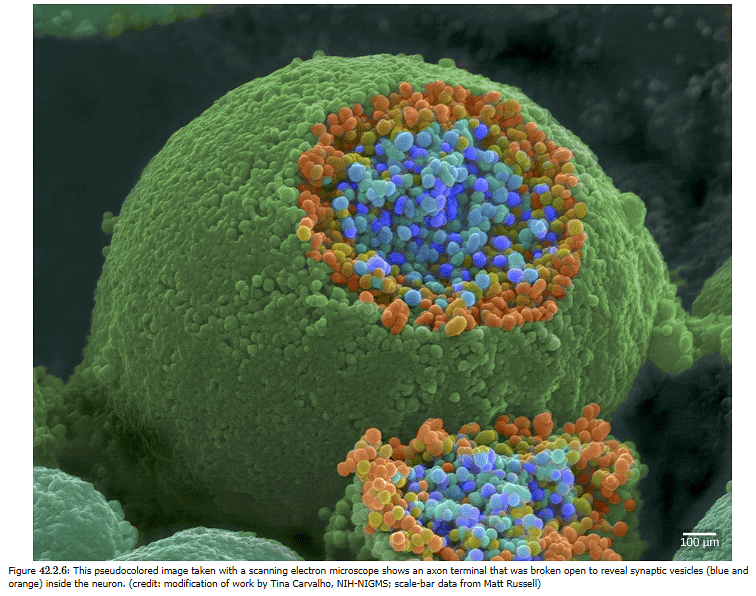
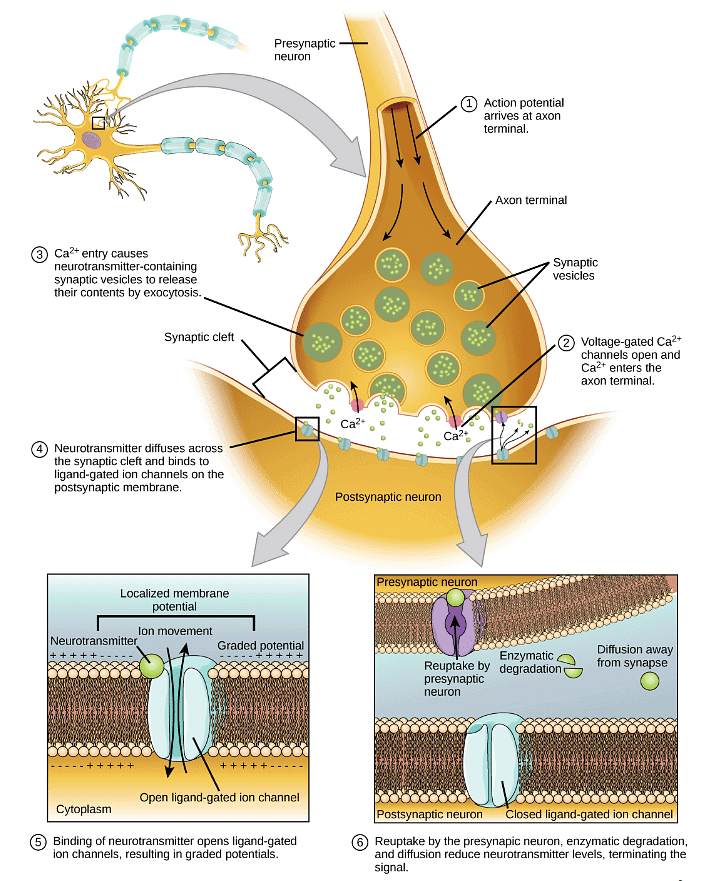
Figure 42.2.7: Communication at chemical synapses requires release of neurotransmitters. When the presynaptic membrane is depolarized, voltage-gated Ca2+ channels open and allow Ca2+ to enter the cell. The calcium entry causes synaptic vesicles to fuse with the membrane and release neurotransmitter molecules into the synaptic cleft. The neurotransmitter diffuses across the synaptic cleft and binds to ligand-gated ion channels in the postsynaptic membrane, resulting in a localized depolarization or hyperpolarization of the postsynaptic neuron.
Neurotransmitter binding, specific to each neurotransmitter, activates particular ion channels, specifically ligand-gated channels, on the postsynaptic membrane, leading to their opening. Neurotransmitters can elicit either excitatory or inhibitory effects on the postsynaptic membrane, as outlined in the table below. For instance, the release of acetylcholine at the neuromuscular junction between a nerve and muscle by a presynaptic neuron induces the opening of postsynaptic Na+ channels. This allows Na+ to enter the postsynaptic cell, causing membrane depolarization. Termed an excitatory postsynaptic potential (EPSP), this depolarization enhances the likelihood of the postsynaptic neuron firing an action potential. In contrast, neurotransmitter release at inhibitory synapses results in inhibitory postsynaptic potentials (IPSPs), leading to a hyperpolarization of the presynaptic membrane. For example, when GABA (gamma-aminobutyric acid) is released, it binds to and opens Cl- channels, causing Cl- ions to enter the cell and hyperpolarize the membrane, reducing the likelihood of firing an action potential.
Following neurotransmission, the neurotransmitter must be cleared from the synaptic cleft to enable the postsynaptic membrane to reset for subsequent signals. This removal can occur through diffusion from the synaptic cleft, degradation by enzymes within the synaptic cleft, or recycling (reuptake) by the presynaptic neuron. Various drugs target this stage of neurotransmission; for instance, certain drugs prescribed for Alzheimer's patients function by inhibiting acetylcholinesterase, the enzyme responsible for acetylcholine degradation. This inhibition increases neurotransmission at synapses releasing acetylcholine, as the neurotransmitter remains in the cleft and can repeatedly bind and unbind to postsynaptic receptors.
Electrical Synapse
While electrical synapses are less abundant than chemical synapses, they are present in all nervous systems and serve unique and crucial functions. The process of neurotransmission in electrical synapses differs significantly from chemical synapses. In electrical synapses, the presynaptic and postsynaptic membranes are closely situated and physically linked by channel proteins that form gap junctions. These junctions facilitate the direct flow of current from one cell to another, allowing not only ions but also other molecules like ATP to diffuse through the broad pores of the gap junctions.
Several notable distinctions exist between chemical and electrical synapses. Chemical synapses rely on the release of neurotransmitter molecules from synaptic vesicles to transmit their signal, resulting in an approximately one-millisecond delay between the arrival of the axon potential at the presynaptic terminal and the opening of postsynaptic ion channels. Additionally, this signaling is unidirectional. In contrast, signaling in electrical synapses is virtually instantaneous, which is crucial for synapses involved in rapid reflexes, and some electrical synapses can transmit signals bidirectionally. Furthermore, electrical synapses are more dependable, less susceptible to blockages, and contribute to synchronizing the electrical activity of a group of neurons. For instance, electrical synapses in the thalamus are believed to regulate slow-wave sleep, and disruptions in these synapses can lead to seizures.
Signal Summation
Occasionally, a single Excitatory Postsynaptic Potential (EPSP) may possess sufficient strength to trigger an action potential in the postsynaptic neuron. However, more frequently, multiple presynaptic inputs need to generate EPSPs concurrently for the postsynaptic neuron to undergo adequate depolarization and initiate an action potential. This phenomenon is termed summation and takes place at the axon hillock, as depicted in Figure 42.2.8. Moreover, a single neuron commonly receives inputs from numerous presynaptic neurons, encompassing both excitatory and inhibitory inputs. In this scenario, Inhibitory Postsynaptic Potentials (IPSPs) can counteract EPSPs, and vice versa. The decisive factor for whether the postsynaptic cell reaches its excitation threshold, necessary for firing an action potential, is the overall change in postsynaptic membrane voltage. The combined effects of synaptic summation and the threshold for excitation function as a filter, ensuring that random "noise" within the system is not transmitted as crucial information.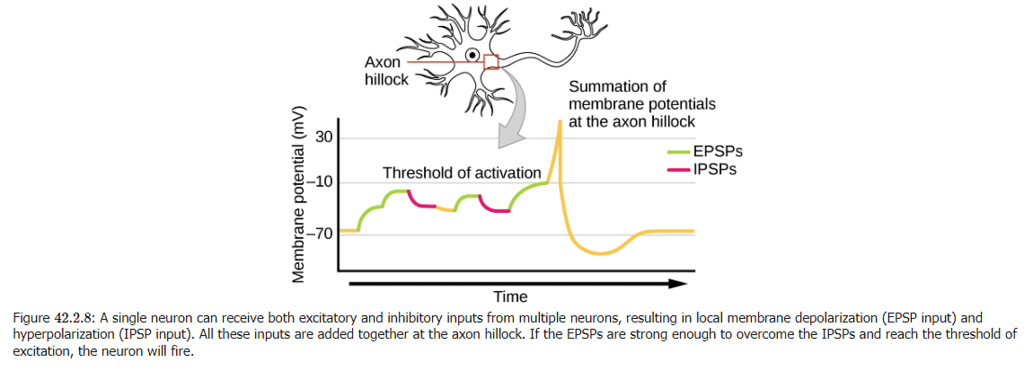
Brain-computer interface
Amyotrophic lateral sclerosis (ALS), commonly known as Lou Gehrig's Disease, is a neurological disorder marked by the progressive degeneration of motor neurons responsible for voluntary muscle control. Initial symptoms involve muscle weakness and coordination issues, ultimately leading to the destruction of neurons controlling vital functions such as speech, breathing, and swallowing. In the advanced stages, the condition results in paralysis, necessitating external assistance for breathing and communication. Innovative technologies have been developed to facilitate communication for "locked-in" patients, allowing them to interact with the outside world. One such technology enables patients to type sentences by using facial twitches, which are then vocalized by a computer.
A cutting-edge approach in assisting paralyzed individuals, including those with ALS, is brain-computer interface (BCI) technology, as depicted in Figure 42.2.9. This technology enables paralyzed patients to operate a computer solely through their thoughts, representing a remarkable advancement. Various forms of BCI exist, some utilizing electroencephalogram (EEG) recordings from electrodes affixed to the skull. These recordings capture information from large neuron populations, decipherable by a computer. Other BCI forms involve the implantation of small electrode arrays, smaller than a postage stamp, in the arm and hand region of the motor cortex. Although more invasive, this form is potent, recording actual action potentials from neurons. The decoded signals are transmitted to a computer, trained to interpret them and convey them to a tool, like a cursor on a computer screen. Consequently, individuals with ALS can engage in activities such as emailing, internet browsing, and communication by simply thinking about moving their hand or arm, despite the inability to physically execute these movements. Recent breakthroughs have enabled a locked-in patient, paralyzed for 15 years due to a stroke, to control a robotic arm and independently drink coffee using BCI technology.
Despite the impressive strides in BCI, it comes with certain limitations. Patients may need extensive training and prolonged periods of concentrated effort. Additionally, some applications may involve brain surgery for device implantation.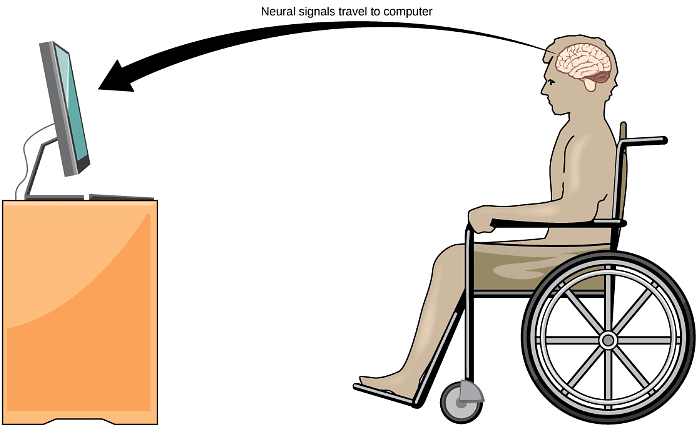
Figure 42.2.9: With brain-computer interface technology, neural signals from a paralyzed patient are collected, decoded, and then fed to a tool, such as a computer, a wheelchair, or a robotic arm.
Synaptic Plasticity
Synapses are dynamic entities capable of undergoing alterations, including weakening or strengthening, breaking, and formation of new connections. Synaptic plasticity is the mechanism facilitating these changes, crucial for the proper functioning of the nervous system. Remarkably, synaptic plasticity serves as the foundation for learning and memory. Among the various processes, long-term potentiation (LTP) and long-term depression (LTD) are notable forms of synaptic plasticity occurring in hippocampal synapses, a brain region dedicated to memory storage.
Long-term Potentiation (LTP)
Long-term potentiation (LTP) is a sustained enhancement of synaptic connections, and its foundation lies in the Hebbian principle: cells that exhibit simultaneous activity develop strengthened connections. The mechanisms contributing to the synaptic reinforcement observed in LTP are not entirely comprehended, but one identified mechanism involves a specific postsynaptic glutamate receptor known as NMDA (N-Methyl-D-aspartate) receptors, as depicted in Figure 42.2.10. These receptors are typically blocked by magnesium ions, but when the postsynaptic neuron experiences depolarization due to rapid and sequential inputs from multiple presynaptic sources, magnesium ions are expelled. This expulsion enables the entry of Ca ions into the postsynaptic cell. Subsequently, the entering Ca2+ ions trigger a signaling cascade leading to the insertion of another type of glutamate receptor, AMPA (α-amino-3-hydroxy-5-methyl-4-isoxazolepropionic acid) receptors, into the postsynaptic membrane. Activated AMPA receptors facilitate the entry of positive ions into the cell. Consequently, when glutamate is released from the presynaptic membrane in the future, it will generate a more pronounced excitatory effect (EPSP) on the postsynaptic cell because the binding of glutamate to these AMPA receptors permits more positive ions to enter the cell. The addition of extra AMPA receptors reinforces the synapse, making the postsynaptic neuron more prone to firing in response to presynaptic neurotransmitter release. Certain substances of abuse exploit the LTP pathway, and this reinforcement of synapses can contribute to the development of addiction.
Long-term Depression (LTD)
Long-term depression (LTD) is essentially the opposite of LTP, involving a prolonged weakening of a synaptic connection. One identified mechanism triggering LTD also involves AMPA receptors. In this scenario, calcium entering through NMDA receptors initiates a distinct signaling cascade, leading to the removal of AMPA receptors from the postsynaptic membrane, as depicted in Figure 42.2.10. The reduction in AMPA receptors in the membrane diminishes the responsiveness of the postsynaptic neuron to glutamate released from the presynaptic neuron. Despite appearing counterintuitive, LTD may be just as crucial for learning and memory as LTP. The weakening and elimination of unused synapses enable the removal of unimportant connections, enhancing the strength of synapses that have undergone LTP in comparison.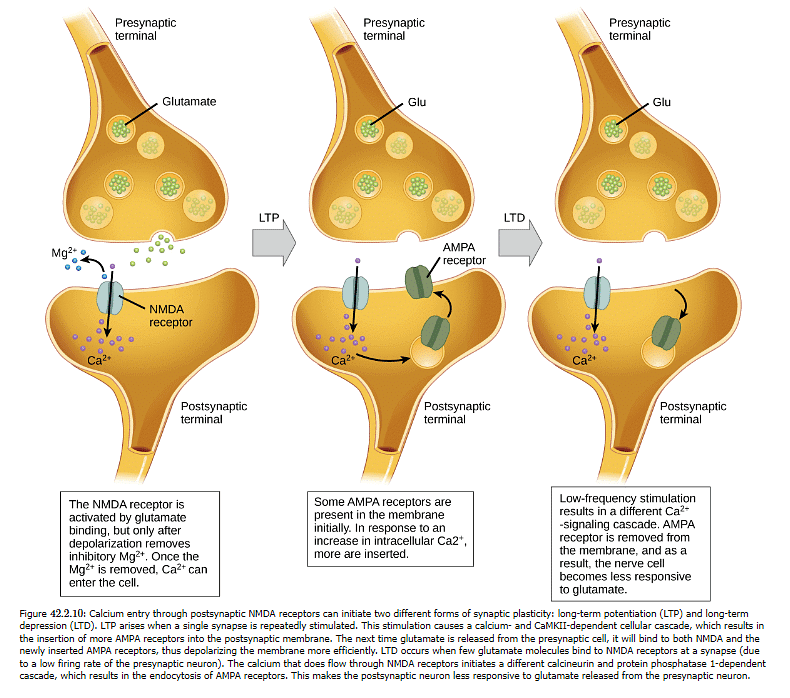
Conclusion
The electrical charge of neuron membranes results from variations in ion concentrations inside and outside the cell, and the movement of ions is regulated by voltage-gated ion channels. When the membrane is depolarized to the threshold of excitation, it triggers the generation of an action potential, which then travels along a myelinated axon to the axon terminals. In chemical synapses, the action potential leads to the release of neurotransmitter molecules into the synaptic cleft. The binding of neurotransmitters to postsynaptic receptors can induce either excitatory or inhibitory postsynaptic potentials, causing depolarization or hyperpolarization of the postsynaptic membrane. In electrical synapses, gap junctions directly transmit the action potential to the postsynaptic cell by connecting the pre-and postsynaptic membranes through large channel proteins. Synapses exhibit dynamic changes and can be either strengthened or weakened. Long-term potentiation and long-term depression are two forms of synaptic plasticity that contribute to these modifications.
|
181 videos|346 docs
|

















